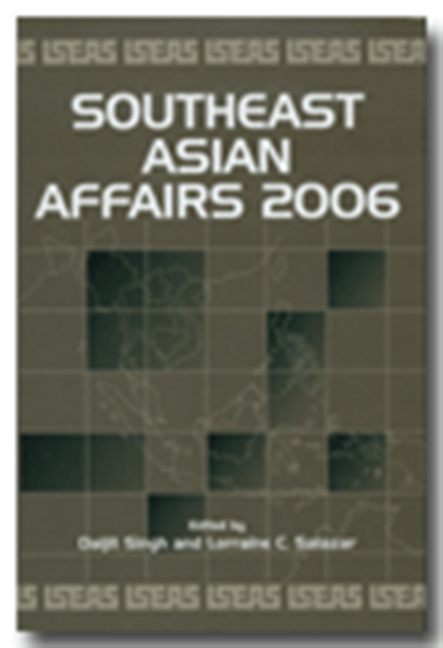Book contents
- Frontmatter
- Contents
- Foreword
- Introduction
- The Region
- Southeast Asia in 2005: Strength in the Face of Adversity
- Southeast Asian Economies: A Year of Exogenous Shocks
- Terrorism: Evolving Regional Alliances and State Failure in Mindanao
- Japan in an Insecure East Asia: Redefining Its Role in East Asian Community-Building
- Brunei darussalam
- Cambodia
- Indonesia
- Laos
- Malaysia
- Myanmar
- The Philippines
- Singapore
- Thailand
- Timor Leste
- Vietnam
Terrorism: Evolving Regional Alliances and State Failure in Mindanao
from The Region
Published online by Cambridge University Press: 21 October 2015
- Frontmatter
- Contents
- Foreword
- Introduction
- The Region
- Southeast Asia in 2005: Strength in the Face of Adversity
- Southeast Asian Economies: A Year of Exogenous Shocks
- Terrorism: Evolving Regional Alliances and State Failure in Mindanao
- Japan in an Insecure East Asia: Redefining Its Role in East Asian Community-Building
- Brunei darussalam
- Cambodia
- Indonesia
- Laos
- Malaysia
- Myanmar
- The Philippines
- Singapore
- Thailand
- Timor Leste
- Vietnam
Summary
The death of Azahari bin Husin in a shoot-out with Indonesian police near the East Java town of Malang on 9 November 2005 was widely acclaimed as the most important victory against the regional terror group Jemaah Islamiyah (JI) since the capture of Hambali. But it became increasingly clear during the year that Malaysian-born Dr Azahari — known as the “Demolition Man” for his skills in assembling the first Bali bombs that killed 202 three years earlier — did not answer to the JI hierarchy and was operating as his own man. Indeed, in 2005 it became obvious that old ways of thinking about JI and regional terrorism were no longer adequate — if they ever were in the first place.
The dominant model, perpetuated in the media by prominent commentators Rohan Gunaratna and Zachary Abuza, views JI as an al-Qaeda franchise, with a clearly demarcated command structure and organizational boundaries, dedicated to the establishment of an Islamic caliphate embracing much of Southeast Asia. To the extent this image was ever valid, as Sidney Jones points out, it represents a five-year-old “snapshot” of JI with little relevance today. A fluid pattern of alignment and realignment between autonomous jihadi factions characterized the terrorist threat in 2005, and this trend is likely to strengthen in the future.
What knits these factions loosely together is not “a very horizontal and exceptionally compartmentalized organization” with a “very rigid cell structure”, as Abuza insisted after Bali's second series of suicide bombings on 1 October 2005, but a shared world-view based on personal allegiances forged in exile, training camps on the Afghan border, or the conflict zones of Sulawesi, Maluku, and — looking forward — Mindanao. Gunaratna has even declared Mindanao the “new strategic base of Jemaah Islamiyah”, but like Abuza, misperceives the nature of this threat.
This overview examines Mindanao's growing role as the regional terrorist crossroads in 2005, but from the perspective of local realities, not externally imposed organigrams.
- Type
- Chapter
- Information
- Southeast Asian Affairs 2006 , pp. 26 - 38Publisher: ISEAS–Yusof Ishak InstitutePrint publication year: 2006



